
- Flocks of sheep facts how to#
- Flocks of sheep facts skin#
Saving Earth Britannica Presents Earth’s To-Do List for the 21st Century.Britannica Beyond We’ve created a new place where questions are at the center of learning.100 Women Britannica celebrates the centennial of the Nineteenth Amendment, highlighting suffragists and history-making politicians.
Flocks of sheep facts how to#
COVID-19 Portal While this global health crisis continues to evolve, it can be useful to look to past pandemics to better understand how to respond today. Student Portal Britannica is the ultimate student resource for key school subjects like history, government, literature, and more. This Time in History In these videos, find out what happened this month (or any month!) in history. About Shropshire Sheep Flexibility for Flock-Owners Great Prolificacy and Longevity Easy Care and Thrifty Top Quality Shropshire Lamb Breed Improvement. #WTFact Videos In #WTFact Britannica shares some of the most bizarre facts we can find. Demystified Videos In Demystified, Britannica has all the answers to your burning questions. Britannica Explains In these videos, Britannica explains a variety of topics and answers frequently asked questions. Britannica Classics Check out these retro videos from Encyclopedia Britannica’s archives. Charge with a charger that puts out 5,000 volts minimum. Four strands of electric fence with the top three strands hot, also works well. Pasture Lambing - Ease of lambing, good mothering instincts, and excellent milk supply make this breed suitable for low labor pasture lambing.įencing needed: 32-inch woven field fencing topped with one or two wires (barbed or electric) will keep the sheep in and the predators out. Lambs reach slaughter weight and are butchered before they go into the rut. No castration needed - Because lambs on good pasture will reach market weights of 90 to 100 lbs in 5 months, no castration is needed. Naturally short tailed - No docking is needed for Icelandic sheep. Our flock is sheared twice a year for best fleece quality. The head is bold and masculine in rams, without horns. Their head is short and broad between the ears and eyes. Their shoulder is strong, smooth and blending well into body. Body of the Shropshire sheep is well fleshed, long, deep and symmetrical. Flocks of sheep facts skin#
This knife shearing is still the method used in Iceland on some farms. Their skin is of a light cherry color, clear and free from dark spots. Or, the fleeces were cut off in June in a process that was similar to skinning, using a hunting type knife. Naturally shedding - Traditionally in Iceland, these animals were rooed (plucked) in February or March when they started to shed. Open fleeces - Icelandic fleaces dry out quickly after a rain, making them a good breed for rainy climates. Sheep and flocks are mentioned hundreds of times in the Bible, using twelve different Hebrew words and four Greek words. They are also thriving in Canada, the hot and humid Midwest, southern California, and Montana where the temperatures range from -38 to 101 degrees Fahrenheit. Sheep on Fescue pasture may need to supplement to get good gains.Ĭlimate range: not yet fully known - they thrive in Iceland's cool, windy, rainy climate, with temperatures ranging from 30 to 52 degrees Fahrenheit. (Most modern meat breeds require large inputs of grain to reach market weight.) No grain needed for Icelandic sheep on excellent pastures.

With rising grain prices worldwide, breeds like the Icelandic Sheep, that thrive on forage alone, will be breeds that will stay economically viable. Adapted to low cost input management - Icelandic sheep have been raised and fattened on grass alone for hundreds of years in a very short growing season.





 0 kommentar(er)
0 kommentar(er)
